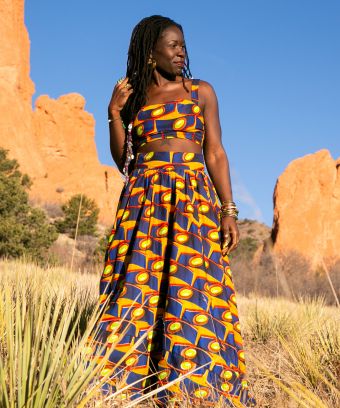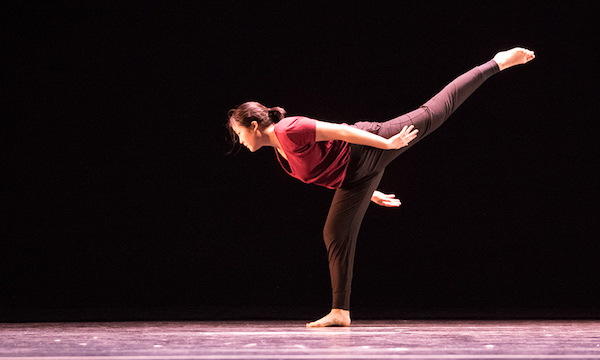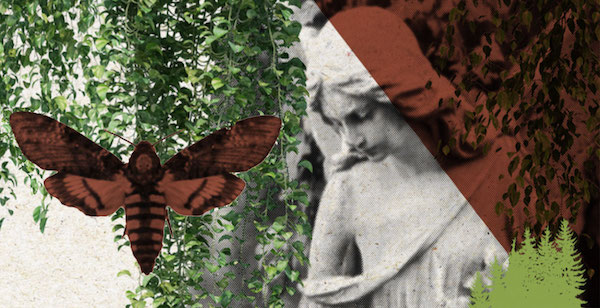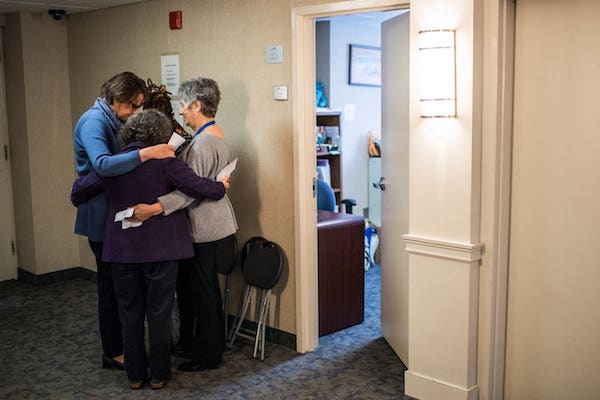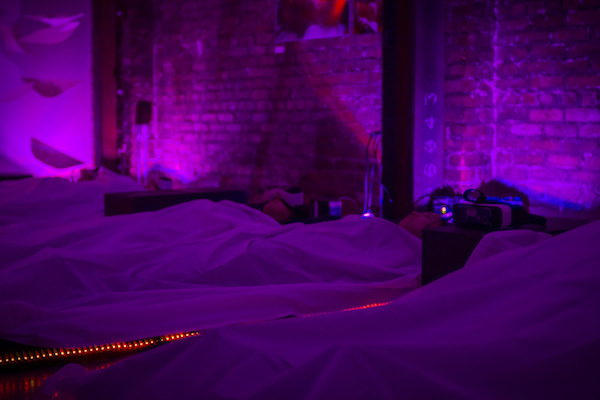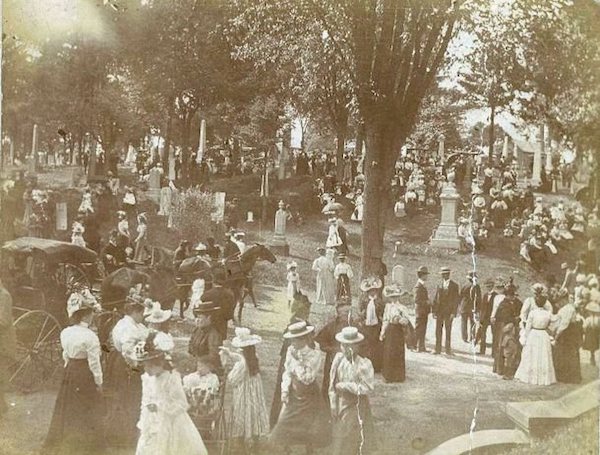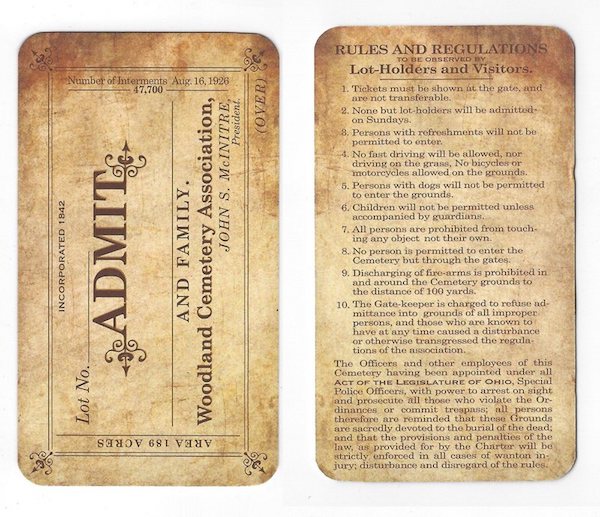By Annie Georgia Greenberg
[T]he building that houses Milward Funeral Directors in Lexington, Kentucky has been around for 193 years. It’s a three-story maze that starts with a light-soaked, stone-floored entrance hallway. The hallway is home to an awfully regal cage of tiny, yellow-breasted finches, and they greet you as you walk in through the funeral home’s front doors. Even when they’re out of sight, you can hear their occasional, lively chirps, particularly if you’re in any of the nearby pastel-hued rooms on the first floor. Say, the powder blue chapel, the pink viewing room, the green family meeting room, or the front office where office associate Elaine Kincaid has found a way to answer the ever-ringing phone with a pressing sense of compassion.
By contrast, it’s nearly pin-drop-silent in the upstairs casket showroom, where, if you were preparing to bury a loved one, you would arrive to find a selection of 30-plus casket models in every variation of wood and steel. Should you be cremating your loved one, there’s an adjoining hall where you could select an urn, each one of them unique in presentation and name — “White Orchid” for the porcelain vase and “Solitude” for the simple, gold rectangle. You could also turn loved ones’ cremated remains into jewelry, a keychain, a bench or, in the words of Miranda Robinson, Milward’s youngest mortician, “pretty much anything you want.”
Like Milward funeral home, Miranda Robinson is polished and professional. Yet, at 30-years old, she both embodies and defies the stereotypes often associated with morticians. Yes, she has a fascination with death and dying. Yes, she loves the skeletal system, owns a black cat, and displays a ouija board on her apartment’s living room table — but she’s anything but morose. In fact, her bubbly Kentucky drawl is often interrupted by a burst of up-swinging giggles, even while discussing death. She used to be a cabaret performer and closely follows RuPaul’s Drag Race. Her most-used word is “lovely” and her retro-feminine personal aesthetic matches that same description.
At around 5 feet, 4 inches tall with an obvious flair for vintage, Miranda pays almost as much attention to her own presentation as she does to those on her embalming table. Robinson clips in hair extensions that she curls every morning. Her arms, which remain covered while at work, are decorated with tattoos. One of them is of a bottle of embalming fluid.
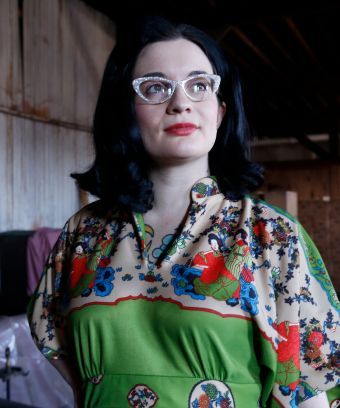 Still, at first blush you’d never guess that Robinson works with the dead on a daily basis. And, perhaps, you’d never guess how many women her age are actively entering the field, either. Frustrated by nursing school and looking for a change, Robinson shifted gears from aiding the living to preserving the dead, and enrolled in mortuary school in Cincinnati, Ohio. In doing so she joined the ranks of young women now outnumbering men in the mortuary education system. In fact, the National Funeral Directors Association reports that, “While funeral service has traditionally been a male-domination profession…today, 60% of mortuary science students in the United States are women.”
Still, at first blush you’d never guess that Robinson works with the dead on a daily basis. And, perhaps, you’d never guess how many women her age are actively entering the field, either. Frustrated by nursing school and looking for a change, Robinson shifted gears from aiding the living to preserving the dead, and enrolled in mortuary school in Cincinnati, Ohio. In doing so she joined the ranks of young women now outnumbering men in the mortuary education system. In fact, the National Funeral Directors Association reports that, “While funeral service has traditionally been a male-domination profession…today, 60% of mortuary science students in the United States are women.”
Once a male-dominated industry, after-life and funeral care is now becoming not only a budding, female-centric space but also one ripe for disruption. And no one knows this better than Miranda. “Even in mortuary school, I was taught that [funeral service] was still a different, difficult field for women.” She explains, “Women, so I’ve heard, were expected to wear skirts and heels still, so it seemed, before I got into the funeral home, that [the] funeral service [industry] hadn’t come a long way for women… but now that I’m here, I feel like I’ve made my mark and I’m really seeing women in funeral service emerge.” They’re emerging and they’re excelling, bringing with them calm, care, and attention to detail that may have long been lacking.
While embalming, Miranda says she feels like “both an artist and a scientist,” because her work combines aspects of both. Made prevalent during the Civil War, when bodies of fallen soldiers were shipped back home for viewings and funerals, embalming is a technique used to preserve the deceased by replacing a portion of their blood with chemicals (including formaldehyde). The body is also made up to look as it did in life — lipstick and all. But, while this method may long be favored in the United States, a new wave of green burial options seeks to challenge the traditional funeral industry. In fact, for the second year running, cremation is now more popular than burials, and the National Funeral Directors Association only expects this trend to continue.
That’s because green burials, alternative and eco-friendly practices are popularizing. Some of these green practices, like home funerals and vigils, pre-date the popularization of embalming, while others like bio-urn cremation (when the body’s cremated remains are buried and grow with the seeds of a plant) or aquamation (a proposed way of breaking down a body using water rather than fire) are brand new. Whether the increased options in funeral care signify an impending end of the traditional funeral industry that Miranda is a part of is a matter that may only be answered in time. For now, what it does mean is that this freshly energized attention to death care is bringing light to a space that, despite touching every single life on Earth, has largely been kept in the shadows.
Ultimately, it is not the method of end-of or after-life care that concerns women like Miranda, but rather the instinct to talk about death in a meaningful way, early and often. Miranda loves her job because what she does helps bring peace to grieving families. She explains, “The most beautiful thing about my job, is taking the loved one into my care from a removal, especially when family is gathered, just that intensity of how much they love that person. It’s an absolute honor to be in the worst possible moment in someone’s life. To be there and for them to look at me and just me to try to at least give them some answers, to try to give them some peace in that moment.”
And while it may seem strange to light up while talking about death, it’s a conversation everyone will someday need to have, regardless of personal preference or spiritual beliefs. Miranda has this conversation every day — at work, at home, with her 1,859 instagram followers — and in doing so helps to de-stigmatize a topic that’s long been off-limits.
As a mortician, Miranda believes that viewing the body is of the utmost importance. As she puts it, “I think it’s important to see the body because you face the reality of what’s actually happened.” But, it’s the trend toward personalization, transparency and increased discussion around death and dying that continues to be a universal priority for many women working in both alternative and traditional funerals.
For Miranda, part of this conversation means addressing the details of her own funeral. And, of course, she can’t imagine anything more fitting than a traditional embalming. Ever the enigma, while her choice to embalm may be traditional, her last look will be anything but. Robinson would like a “glitter casket” with a leopard interior. Dark brown extensions will be clipped and curled, her lips will be painted in the bright red pigment Ruby Woo by Mac. Years from now, when that day comes, Miranda may very well lay on the table that she works alongside every single day at Milward Funeral Directors, in the storied embalming room that she considers sacred. Perhaps somewhere beneath her in the entry hall, the finches will be singing.
Complete Article ↪HERE↩!



